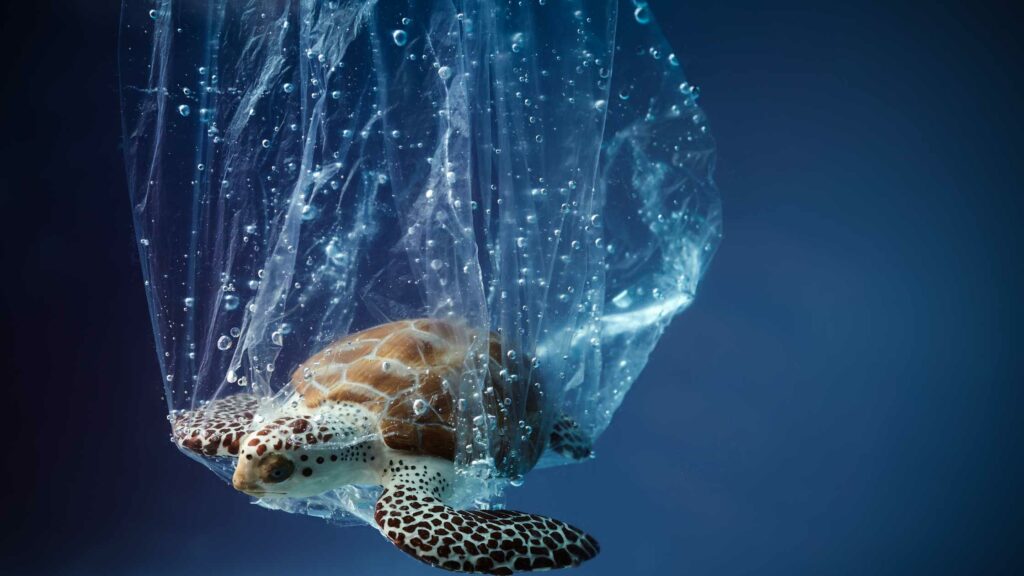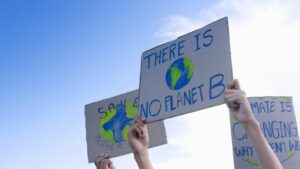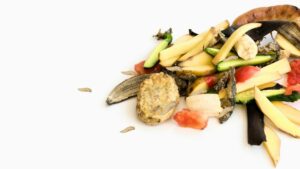Startseite » BIOvative Magazine » Ocean Plastic
Ocean Plastic: Greenwashing oder Lösung gegen die Plastikflut?
Content
- We are suffocating in plastic waste
- What is "Ocean Plastic" and how does it contribute to solving the crisis?
- How can plastic be recycled?
- How can "Ocean Plastic" be recycled?
- Greenwashing with „Ocean Plastic“
- Adidas x Parley
- Coca Cola’s disposable bottles from marine plastic
- Positive action against "Ocean Plastic"
- The Ocean Cleanup
- One Earth – One Ocean
- Everwave
- Stay skeptical
Ocean Plastic: Greenwashing oder Lösung gegen die Plastikflut?
- 7. September 2023
- Autor: Philipp Dyllong
- Lesezeit: 11 Minuten
A term that has been in the media a lot in recent years is “Ocean Plastic”. Here, companies manufacture their products from plastic waste collected in the sea and at the same time fight the plastic flood in our oceans. At least that’s what Adidas, Henkel and co. tell us.
In this article you will find out how much there really is to these claims and whether this is just greenwashing again. Because if it were really that simple, why don’t many more companies do it that way?

We are suffocating in plastic waste
Since the 1950s, it is hard to imagine our everyday life without plastic. While “only” 1.5 million tons of plastic were produced per year back then, today it is already almost 400 million tons per year and some estimates assume 1 billion tons per year in 2050. In Europe alone, 1.5 million people work in plastic production.
A large part of this plastic ends up in the oceans – about 4.8 to 12.7 million tons per year. About 80% comes from Asia, especially China, the Philippines, Indonesia, Thailand and Vietnam cause large amounts of waste. Due to inadequate waste disposal systems, the plastic enters the sea via rivers.
There, large floating waste whirlpools form, each containing several million tons of plastic. However, these waste whirlpools represent only about 15% of the plastic waste in our oceans. Another 15% is washed up again and an incredible 70% gradually sinks to the ocean floor.
What is "Ocean Plastic" and how does it contribute to solving the crisis?
As is often the case in the field of sustainable business, the term “ocean plastic” is not precisely defined and thus offers a great deal of room for interpretation, which companies are happy to use. However, since it is often advertised as making the oceans cleaner, it seems reasonable to assume that “ocean plastic” means plastics that have been fished out of the ocean. You’ll learn why this distinction is important later in the article.
Basically, the concept of “Ocean Plastic” is a recycling method. So let’s take a quick look at the recyclability of plastic.
How can plastic be recycled?
As you probably know, traditional plastics consist largely of the fossil energy source petroleum. By various industrial processes, plastics are produced from it, for example polypropylene (PP), polyethylene terephthalate (PET) or polyamide (PA), which are used for various purposes.
There are various methods for making this plastic usable again. In thermal recycling, the plastic is simply burned and there is a risk of toxicity and CO2 is released. Recycling, of course, is not. In feedstock recycling, the plastic is broken down under high temperatures and with a corresponding energy requirement.
In mechanical recycling, on the other hand, the plastic is sorted, processed and ground into granules, which in turn can be used to create new products. This method is thus the most environmentally friendly and generally quite efficient.
How can "Ocean Plastic" be recycled?
In order to create new products from “Ocean Plastic”, the waste must therefore be materially recycled. This means that the waste must be collected, sorted, cleaned and further processed. Often, however, garbage from the oceans is very heavily contaminated and mixed and must first be laboriously freed of sand, lime and other deposits before any sorting and further processing can even be considered.
According to Gilian Gerke – professor of waste management at Magdeburg-Stendal University of Applied Sciences – this process is extremely complex and difficult to imagine on an industrial scale. Often, therefore, only part of the waste is reused, empty plastic bottles, for example. Accordingly, claims by large companies to actually use “ocean plastic” seem unlikely. Collected garbage that cannot be reprocessed is often incinerated as well. So let’s now take a brief look at some examples.
Greenwashing with "Ocean Plastic“
Adidas x Parley
In its collaboration with the environmental organization Parley for the Oceans, which has been running since 2015, Adidas has been offering shoes made from “Ocean Plastic” for several years. In doing so, the company conveys to customers that the plastics used in the yarns come from marine waste.
These claims cannot be verified, and in light of the expert opinion of Ms. Gerke from the Magdeburg-Stendal University of Applied Sciences, it seems unlikely that such an elaborate manufacturing process would ultimately result in a pair of shoes for only 150 euros.
Adidas is using a classic greenwashing technique here by making statements for which it then provides no evidence. When asked, the company admits that the plastic comes from beaches and coastal regions and was recycled there before it was released into the ocean. Of course, recycling was done and trash was recycled. Consumers were nevertheless misled about the origin of the plastic, because it did not come from the oceans at all.
Coca Cola’s disposable bottles from marine plastic
In 2019, the group announced that its disposable bottles would in future consist of 25% marine plastic. However, this is intended to distract from the fact that Coca Cola is the world’s largest producer of packaging waste. The company alone is responsible for more than 3 million tons of plastic products each year.
The main problem, however, is that this immense number is almost exclusively disposable bottles, which pollute our environment heavily. In over 50 countries, Coca-Cola products have been identified as one of the main sources of plastic pollution.
The solution here cannot be to gloss over a small part of one’s own plastic waste by recycling, but only to take active action against it by means of reusable systems. Coca-Cola is clearly using a clandestine compromise here to divert attention from the big picture. If you want to learn more about this, we have an article here on more techniques to deceive you by greenwashing.
Positive action against "Ocean Plastic"
In addition to the inevitable black sheep, however, there are also some companies and organizations that have taken up the cause of combating “ocean plastic”. Here we would like to briefly introduce you to some of the most promising:
The Ocean Cleanup
Probably many have already heard of “The Ocean Cleanup” (short: TOC) in connection with Ocean Plastic. The project was founded by Dutchman Boyan Slat. TOC has developed long trawl nets with which it slowly travels the most polluted areas of the ocean and thus collects the garbage floating on the surface. The slow speed means there is no bycatch, which means no creatures get caught in the nets. Meanwhile, TOC is tinkering with the third and largest version of its system to become more scalable and efficient.
One Earth – One Ocean
A similar approach is taken by the organization “One Earth – One Ocean” (OE-OO for short). Instead of focusing mainly on the open seas, OE-OO has turned its attention to coastal areas, estuaries and inland waters. Two different catamarans also collect trash floating on the water’s surface during “One Earth – One Ocean.” At the same time, field research is carried out directly on site with regard to the plastics found.
In addition, the organization is currently working on a ship that will be used to recycle the collected waste directly on site.
Everwave
Everwave is also committed to combating the flood of waste in our waters. Originally, an innovative system was developed for this purpose, which makes use of the current forces in the sea and thus not only conveys and collects plastic waste from the surface, but also from deeper layers. Since 70% of plastic waste sinks to the bottom, this is a really good idea.
Unfortunately, these platforms are currently only used in rivers, as they are too vulnerable for the open sea. Nevertheless, they naturally collect a huge amount of trash there that would otherwise be transported into the oceans. In addition, Everwave also uses garbage collection boats, similar to OE – OO.
Stay skeptical
As so often, companies also use the issue of plastic waste or ocean pollution for marketing purposes. This often results in greenwashing, sometimes accidentally, but often intentionally. Therefore, as with other claims about sustainability and environmental issues, you should be very careful with these statements. How you can recognize greenwashing attempts, you can find out here.
Besides a lot of black sheep, there are also a few bright spots, as we hope we could show you. As a general rule, always remain skeptical and question things.
Want to stay up to date? Sign up for our newsletter and follow us on social media to automatically receive news about the Climate Protection Act and other exciting sustainability topics from us!

Philipp Dyllong

Philipp Dyllong
These articles might also interest you

DINplus organic waste bag certification – for a clean garbage can
Content DINplus organic waste certification Advantages of DINplus certification Requirements of the DINplus certificate The certificate DINplus in detail Compostability at DINplus Basis for certification

Klimaschutzklage: Wie gut stehen Deine Chancen, erfolgreich eine lebenswerte Zukunft einzuklagen?
Content The most important facts about the climate protection lawsuit Your right to climate protection The legal basis for the climate protection lawsuit Liveable future

Maggots in the organic waste garbage can: what to do?
Contents This helps against maggots in the organic waste garbage can The right location for the organic waste garbage can Avoid humidity Keep garbage cans


